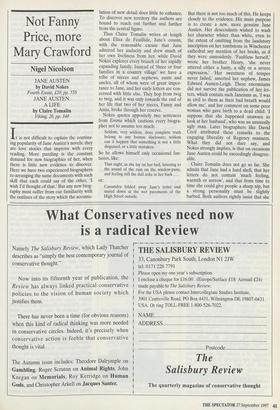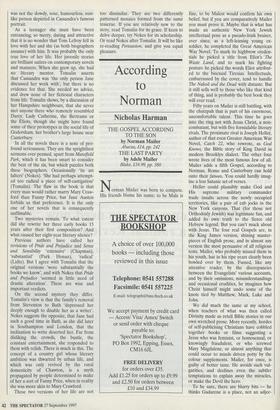Not Fanny Price, more Mary Crawford
Nigel Nicolson
It is not difficult to explain the continu- ing popularity of Jane Austen's novels: they are love stories that improve with every reading. More puzzling is the constant demand for new biographies of her, when there is little new evidence to discover. Here we have two experienced biographers re-arranging the same documents with such skill that each could say of the other, 'I wish I'd thought of that.' But any new biog- raphy must suffer from our familiarity with the outlines of the story which the accumu- lation of new detail does little to enhance. To discover new territory the authors are bound to reach out further and further from the central figure.
Thus Claire Tomalin writes at length about Eliza de Feuillide, Jane's cousin, with the reasonable excuse that Jane admired her audacity and drew much of her own liveliness from her, while David Nokes explores every branch of her rapidly expanding family. Instead of 'three or four families in a country village' we have a tribe of nieces and nephews, aunts and uncles, all of whom were of great impor- tance to Jane, and her early letters are con- cerned with little else. They hop from twig to twig, and it was only towards the end of her life that two of her nieces, Fanny and Anna, broke through her reserve.
Nokes quotes appositely two sentences from Emma which cautions every biogra- pher not to assume too much:
Seldom, very seldom, does complete truth belong to any human disclosure; seldom can it happen that something is not a little disguised, or a little mistaken.
So he allows himself only occasional fan- tasies, like:
That night, as she lay on her bed, listening to the sound of the rain on the window-pane, and feeling still the dull ache in her back ...
or:
Cassandra folded away Jane's letter and stared down at the wet pavements of the High Street outside.
But there is not too much of this. He keeps closely to the evidence. His main purpose is to create a new, more genuine Jane Austen. Her descendants wished to wash her character whiter than white, even to the extent of omitting from the laudatory inscription on her tombstone in Winchester cathedral any mention of her books, as if they were unmaidenly. 'Faultless herself,' wrote her brother Henry, 'she never uttered either a hasty, a silly or a severe expression.' Her sweetness of temper never failed,' asserted her nephew, James Edward Austen-Leigh. These encomiums did not survive the publication of her let- ters, which contain such Janeisms as, 'I was as civil to them as their bad breath would allow me', and her comment on some poor woman who gave birth to a dead child: 'I suppose that she happened unaware to look at her husband', who was an unusually ugly man. Later biographers like David Cecil attributed these remarks to the engaging liberality of Regency manners. What they did not dare say, and Nokes strongly implies, is that on occasions Jane Austen could be exceedingly disagree- able.
Claire Tomalin does not go so far. She admits that Jane had a hard shell, that her letters do not contain 'much feeling, warmth or sorrow', and that from time to time she could give people a sharp nip, but a strong personality must be slightly barbed. Both authors rightly insist that she was not the dowdy, sour, humourless, nun- like person depicted in Cassandra's famous portrait.
As a teenager she must have been entrancing, so merry, daring and attractive that it is no wonder that Tom Lefroy fell in love with her and she (as both biographers assume) with him. It was probably the only true love of her life. Her juvenile stories are brilliant satires on contemporary novels and manners. When she grew up, she had no literary mentor. Tomalin asserts that Cassandra was 'the only person Jane discussed her work with', but there is no evidence for that. She needed no advice, and drew none of her fictional characters from life. Tomalin shows, by a discussion of her Hampshire neighbours, that she never met anyone there who remotely resembled Darcy, Lady Catherine, the Bertrams or the Eliots, though she might have found some of their prototypes in the social life of Godersham, her brother's large house near Canterbury.
In all the novels there is a note of pro- found seriousness. They are the sprightliest sermons ever penned, apart from Mansfield Park, which it has been smart to consider the best of the six, but which puzzles both these biographers. Occasionally 'its art falters' (Nokes). 'She had perhaps attempt- ed too radical a piece of self-castigation' (Tomalin). The flaw in the book is that every man would rather marry Mary Craw- ford than Fanny Price, but Jane Austen forbids us that preference. It is the only one of her novels that is consequently unfilmable.
Two mysteries remain. To what extent did she rewrite her three early books 15 years after their first composition? And what caused her eight-year literary silence?
Previous authors have called her revisions of Pride and Prejudice and Sense and Sensibility 'extensive' (Chapman), `substantial' (Park Honan), 'radical' (Lidtz). But I agree with Tomalin that the original versions 'were substantially the books we know', and with Nokes that Pride and Prejudice 'seemed in little need of drastic alteration'. These are wise and important verdicts.
On the second mystery they differ. Tomalin's view is that the family's removal from Steventon to Bath 'depressed her deeply enough to disable her as a writer'. Nokes suggests the opposite, that Jane had such a good time in Bath, as she did later in Southampton and London, that the inclination to write deserted her. Far from disliking the crowds, the bustle, the constant entertainment, she responded to them with relish. There is much in this. The concept of a country girl whose literary ambition was thwarted by urban life, and which was only revived by the rural domesticity of Chawton, is a myth propagated by people determined to make of her a sort of Fanny Price, when in reality she was more akin to Mary Crawford.
These two versions of her life are not too dissimilar. They are two differently patterned mosaics formed from the same tesserae. If you are relatively new to the story, read Tomalin for its grace. If keen to delve deeper, try Nokes for its scholarship. Or read Nokes after Tomalin. It will be like re-reading Persuasion, and give you equal pleasure.











































































 Previous page
Previous page